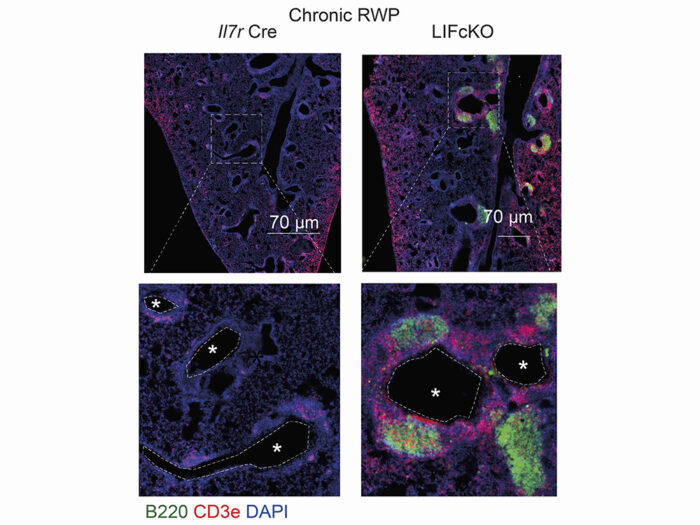Leukaemia inhibitory factor (LIF) production by type-2 innate lymphoid cells dictates the movement of immune cells from the site of lung infection or chronic allergic reaction, thereby regulating tissue localised versus systemic immunity

By MRC Laboratory of Molecular Biology, licensed under CC BY 4.0.
Upon infection by a new virus the immune system has two key actions: to fight the virus at the site of infection, and to develop a ‘memory’ of how to fight the virus in the future, known as systemic immunity. In order to develop systemic immunity, some immune cells need to migrate from infected tissue to lymph nodes where they activate the adaptive ‘memory’ immune system. The immune cells follow chemical signals produced by cells lining the lymphatic vessels, guiding them to where they are needed. However, it has previously been unclear how these guidance signals are initiated and regulated. Addressing this, Andrew McKenzie’s group, in the LMB’s PNAC Division, have identified that the production of cytokine substance leukaemia inhibitory factor (LIF) by type-2 innate lymphoid cells controls the movement of immune cells from the site of infection to lymph nodes.
Led by Mayuri Gogoi, the group specifically focused on the role of LIF production by type-2 innate lymphoid cells (ILC2s) during viral lung infections in mice. They introduced the experimental disease model pneumovirus, which replicates common respiratory viruses in humans such as respiratory syncytial virus (RSV). They found that when LIF is missing from ILC2s, other immune cells remain in the lungs, rather than travelling to the lymph node. While this may speed up virus clearing at the initial site of infection, it does not build the ‘memory’ of how to fight the virus so impairs the body’s ability to deal with future reinfection.
The group also introduced chronic allergen challenges to the mice to simulate allergen-induced asthma. They found that when immune cells are unable to leave the lungs during ongoing allergic reactions owing to missing LIF, they form unique structures named tertiary lymphoid structures, also known as iBALT. These structures take the form of inducible bronchus associated lymphoid tissues, a localised inflammation associated with chronic allergic responses.
Further investigation into the role of LIF revealed it influences the production of the chemical signal CCL21 by lymphatic endothelial cells. The CCL21 signal guides immune cells from the site of infection in the lungs to the nearby pulmonary lymph nodes. This helps maintain the correct balance between local and systemic immune responses when fighting viral infections and allergic reactions.
This research furthers our understanding of how the immune system works and underlines the previously unknown importance of LIF to orchestrate the highly dynamic system of migration and homing of specialised immune cells. This also opens up future opportunities to identify if there are any additional LIF-dependent signals which contribute to immune cell migration. Finally, low LIF expression has also been identified in a wide variety of other diseases, such as inflammatory bowel disease and certain cancers. Thus, further investigations into the cytokine may shed more light on the molecular mechanisms behind these conditions.
This work was funded by UKRI MRC, the Wellcome Trust, Gates Cambridge Trust, and the Rosetrees Trust.

This project has received funding from the European Union’s Horizon 2020 research and innovation programme under grant agreement No 832620.
Further references
ILC2-derived LIF licences progression from tissue-localised to systemic immunity. Gogoi, M., Clark, P.A., Ferreira, A.C.F., Rodriguez, N. R., Heycock, M., Ko, M., Murphy, J., Chen, V., Luan, S-L., Jolin, H.E., McKenzie, A.N.J. Nature
Andrew’s group page
Previous Insight on Research articles
Transcription factor Mef2d is crucial to the function of type-2 innate lymphoid cells during allergic responses
Neuroprotective protein ADNP is vital to immune reactions to allergens
Integrin-mediated T helper 2 cell clustering revealed as key step and potential therapeutic target in allergic immune response
Animal research statement
As a publicly funded research institute, the LMB is committed to engagement and transparency in all aspects of its research. This research used mice, in accordance with the UK Animals (Scientific Procedures) Act 1986. This work was conducted under a Project Licence, reviewed and approved by the MRC Laboratory of Molecular Biology (LMB) Animal Welfare and Ethical Review Body (AWERB) committee and the UK Home Office.
The LMB uses the minimum number of rodents necessary to achieve results and only uses animals in research where there are no suitable alternatives, in line with the 3R’s (replace, reduce, refine). We currently work with fruit flies, nematode worms, mice, rats and zebrafish.